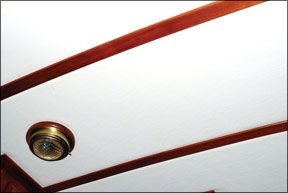The headliner in my boats cabin is beginning to sag. I have tried to secure it to the overhead again, but I am having problems finding a glue applicator that wont leave any holes in the liner. Do you have any suggestions? Alan Bolyard Via e-mail Most production boatbuilders make an honest effort to put headliners where they belong and get them to stay there. However, the glue that keeps the headliner in place lives a tough life. They go through thousands of heating and cooling cycles, which can be hard on the sticky stuff. Injecting glue in select locations through a headliner is tough indeed. It often ends up ruining the appearance of the headliner. A reasonable alternative is to install battens across the headliner, screwed in place, at evenly spaced locations, either athwart ships (the traditional approach) or fore to aft, whichever is most aesthetically pleasing to you. The battens can be 288 made of thin strips (usually 0.25 x 2 inches) of teak, mahogany, or any wood you prefer. Stain or varnish it as you please. Drill holes in the cabin top (watch out for wires) using a drill and drill bit thats equipped with a drill stop, so you don’t inadvertently drill through the cabin top. If you can estimate the deck thickness by accessing a hole, where a hatch is located for instance, this will help you determine how deeply to drill. Remember, however, the screw that secures the batten only has to penetrate the inner fiberglass skin, so its unlikely that your exposed drill bit above the drill stop will be more than .25 inches long. If the coach roof core is wet, the new screw holes may mean new leaks. Use sealant on the threads, and drill the hole a size smaller than the self-tapping screws to be used. This should make for a long-lasting fix. Cabin Ventilation I have a 29-foot boat with a beautiful cabin that closes tight, but moisture gathers inside as if the hatch was open. Any ideas? James Krasnow Via e-mail This, of course, leads to mildew problems. Still, no boat can or should be closed up as tight as a drum. What you need is proper ventilation and circulation of fresh air. Solar vents are an excellent method of providing the requisite air turnover within your vessels cabin when its otherwise closed up tight. If a single ordinary vent doesn’t provide enough ventilation to eliminate your mildew problem, you may have to resort to solar vents with auxiliary battery back-up power. These vents, made by Nicro, use solar power to operate their fans during daylight hours and rechargeable batteries (these are recharged from the built-in solar panel) for operation during the evening. Thus, you can effectively provide 24-hour ventilation, doubling or tripling the volume of air moving through the cabin. The vents also may be used in pairs, one drawing fresh air into the cabin, through the forward cabin for instance, and another exhausting air from another location, from the galley, aft cabin, or main saloon, setting up cross ventilation. The fans within solar vents can be removed and reversed in order to control the direction of flow, in or out of the cabin. 






































